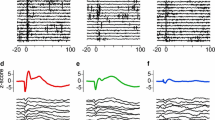Summary
The cerebellar nuclei of rhesus monkeys were stimulated electrically and evoked responses of the tongue recorded with force-displacement transducers and electromyographically. Stimulation of the dentate (DN) and fastigial (FN) nuclei produced different effects on the tongue musculature, the former evoking movements characterized by changes in both the lateral and anteroposterior (AP) dimensions of the tongue and the latter movements associated with a preferential change in the AP dimension. While all three deep nuclei influenced the genioglossus muscle, the influences varied across nuclei in the following manner: FN produced the largest amplitude genioglossus mediated AP excursions and DN the smallest, with the nucleus interpositus (NI) occupying an intermediate position; and, FN and medial NI stimulation evoked changes in genioglossus respiratory activity whereas DN stimulation did not. These data indicate that the cerebellar tongue representation is organized into different functional zones and that within an anatomically broad representation of a single target muscle, nuclear functional specificity exists.
Similar content being viewed by others
References
Aides L D, Bowman J P (1979) Representation of the tongue in the cerebellar nuclei of the monkey. Exp Neurol 64: 202–215
Bantli H, Bloedel H R (1976) Characteristics of the output from the dentate nucleus to spinal motoneurons via pathways which do not involve the primary sensory cortex. Exp Brain Res 25: 199–220
Bowman J P (1971) The muscle spindle and neural control of the tongue. Thomas, Springfield
Brown J R, Darley F L, Aronson A E (1970) Ataxic dysarthria. Int J Neurol 7: 302–318
Chambers W W, Sprague J M (1955a) Functional localization in the cerebellum I. Organization in longitudinal cortico-nuclear zones and their contribution to the control of posture, both pyramidal and extrapyramidal. J Comp Neurol 103: 105–129
Chambers W W, Sprague J M (1955b) Functional localization in the cerebellum II. Somatotopic organization in cortex and nuclei. Arch Neurol Psychiat 74: 653–680
Darley F L, Aronson A E, Brown J R (1975) Motor speech disorders. Saunders, Philadelphia
Dow R S, Moruzzi G (1958) The physiology and pathology of the cerebellum. University of Minnesota Press, Minneapolis
Hampson J L, Harrison C R, Woolsey C N (1952) Cerebrocerebellar projections and the somatotopic localization of motor function in the cerebellum. A Res Nerv Ment Dis Proc 30: 299–316
Holmes G (1956) The Croonian lectures on the clinical symptoms of cerebellar disease and their interpretation. In: Walshe F (ed) Selected papers of Sir Gordon Holmes. Macmillan, London
Ito M (1970) Neurophysiological aspects of the cerebellar motor control system. Int J Neurol 7: 162–176
Kent R, Netsell R (1975) A case study of an ataxic dysarthric: cineradiographic and spectrographic observations. J Speech Hear Res 40: 115–134
McDonald J V, Okawara S (1968) The effect of frequency changes on response to electrical stimulation of the cerebellum in the unanesthetized cat. J Nerv Ment Dis 147: 65–69
Pompeiano O (1958) Responses to electrical stimulation of the intermediate part of the cerebellar anterior lobe in the decerebrate cat. Arch Ital Biol 96: 330–360
Pompeiano O (1967) Functional organization of the cerebellar projections to the spinal cord. In: Schade J (ed) The cerebellum. Progress in brain research, vol 25, Eisevier, New York, pp 282–321
Schultz W, Montgomery E B, Marini R (1976) Stereotyped flexion of forelimb and hindlimb to microstimulation of dentate nucleus in cebus monkeys. Brain Res 107: 151–155
Schultz W, Montgomery E B, Marini R (1979) Proximal limb movements in response to microstimulation of primate dentate and interpositus nuclei mediated by brain-stem structures. Brain 102: 127–146
Author information
Authors and Affiliations
Rights and permissions
About this article
Cite this article
Bowman, J.P., Aldes, L.D. Organization of the cerebellar tongue representation in the monkey. Exp Brain Res 39, 249–259 (1980). https://doi.org/10.1007/BF00237114
Received:
Issue Date:
DOI: https://doi.org/10.1007/BF00237114




